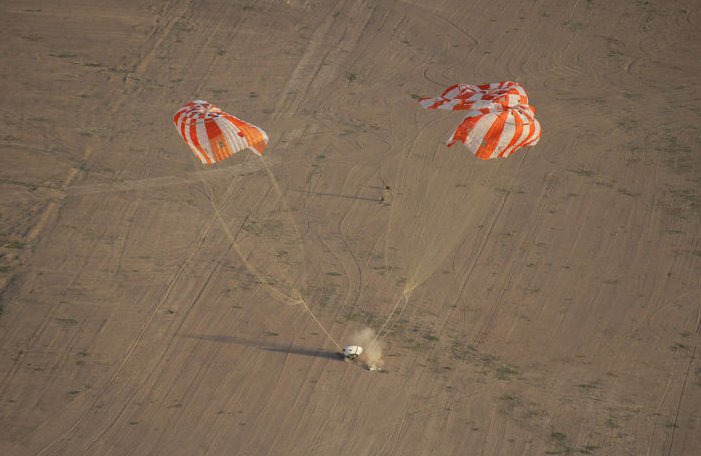
Last week, NASA’s acting chief technologist, Douglas Terrier, visited one of NASA’s main contractors in the Houston area, Jacobs. Along with a handful of media members, he spent about an hour touring the company’s engineering development facility, where the company supports NASA programs from the International Space Station to the Orion spacecraft.
At one stop during the tour, Terrier learned about a new distiller that might more efficiently recover water from urine during long-duration missions. At another, he learned about new debris sensors that will go to the station to record micrometeorite and orbital debris impacts. And at yet another, he heard about the parachute system that Jacobs has helped develop for the Orion spacecraft.
The Jacobs engineer who talked about the contract said the company had partnered with several Houston-based firms and leveraged knowledge from the region’s large oil-and-gas economy. These partnerships, she said, had saved money for NASA over the course of the agency’s 11-year contract with Jacobs to design and build Orion’s parachutes.Terrier continued to nod pleasantly along and ask insightful questions. The tour went on. But inwardly, I was taken aback. Surely, it did not take 11 years (and counting) to develop and test parachutes for a spacecraft. After all, between 1961 and 1972, humans went from first taking flight with Yuri Gagarin, to flying Apollo missions to the Moon. And if it was true, what did it mean for where NASA was really going in terms of human exploration?
11 years
It was true. According to NASA spokeswoman Barbara Zelon, the contract for the development and certification of the Orion parachute system has been in place for 11 years. This included early concept and trade studies, numerous ground-based tests, and 17 full-scale development airdrop tests required to prove out a wide range of failure scenarios. Finally, Orion has completed three of the final eight human certification airdrop tests and plans to complete human certification in early 2019. So Jacobs is likely to have a parachute development contract for at least 13 years.
In some sense, this is what NASA does. It tests out new technologies on the frontier of exploration and then shares them with industry. For example, Zelon said, NASA has shared more than 300 artifacts, including the design, models, and test data, with the agency’s commercial crew partners—Boeing and SpaceX. This has allowed them to leverage NASA’s efforts and eliminate nearly all the development work and unique testing. This saves both NASA and the companies money in the long run.
But what does it say about an exploration program that requires 13 years to develop a parachute system? After all, NASA’s Mercury, Gemini, and Apollo capsules all had parachute systems, too, and each was developed within a few years. NASA had a broad base of knowledge to draw on (Orion will probably only ever come back from the Moon, like the Apollo capsules, although it is larger). It seemed like a 13-year contract for parachute development may indicate that the agency really wasn’t going anywhere fast.
A “fair” question
After the Jacobs tour, I put this question to Terrier. He did not flinch. “I think it’s a very fair question,” he said. ”I think it’s a very fair debate to ask if we as a nation are serious about this, and making it a priority. What we’ve enjoyed is a very constant level of support, but it’s certainly not the Apollo or Manhattan-type project to crank this thing out in seven years.”
That is not to say that NASA, or its large contractor base, is less able than it was in the 1960s. Far from it, Terrier said. “I think it’s important to realize that the team and the technology and manufacturing base is very capable of doing that, the moment someone flicks that switch. The speed at which we’re moving is not limited by the capability of NASA or the contractors; it is limited by the resources and, frankly, the political emphasis.”
Here, Terrier has highlighted the biggest reason why the United States and NASA have not moved beyond the Moon since 1969, or indeed, even sent humans back. Once the Apollo program met its Cold War imperative, NASA’s priority sank, and the funding dried up. NASA has been left with significantly less money, relative to the rest of the federal budget, since then. It then tried to cobble together a meaningful human-exploration program in low Earth orbit with the shuttle and space station.
Perhaps the new administration will change this. Vice President Mike Pence has spoken about a renewed human exploration plan along with a willingness to inject more low-cost, commercial space into the mix to push NASA further, faster. Certainly, the potential is there. But for now, at least, the switch has yet to be flicked on.
reader comments
124